
|
The world of non-commercial film and A-V |
Events Diary | Search | ||
| The Film and Video Institute | | ||||
The making of The Thames Tunnel
his film The Thames Tunnel won a Gold Standard Award, Best Use of Sound and a sponsor's prize from Boosey & Hawkes
Sound Thinking ...
I feared that the story of The Thames Tunnel was a potentially boring subject for a video - lots of static images, little visual movement, and cries from IAC stalwarts that it would have been better as an A/V show. So I sought to enliven the visuals with a compelling and entertaining soundtrack, an embellishment to lift the video out of the humdrum.
I looked firstly for suitably evocative music to reflect the age, the ambition and the optimistic grandeur of the project. But I was also looking for music to reflect the contrasting moods of the different stages of the project - the optimism of the early work, the mounting tensions as things started to go wrong, the depression after the deaths and floods, the contrast between the gloom of 1828 and the euphoria of 1834 when work restarted, and 9 years later, when the Tunnel opened to such acclaim.
Not having the luxury of specially composed music, I was fortunate to find what I wanted in Christine Collins' and my CD collections.
Using Music as Punctuation
Once I had the music, I tried in several key sections to edit the sequences to it. I shortened some clips, lengthened others, deleted here, added one in there, so that the music almost exactly tied in with the visuals.
The Tunnel Opening sequence, for example, was manipulated so that the music peaks just as the commentary talks of the eighth wonder of the world. At the end, the music reaches a crescendo just as the voiceover finishes (and the underground train moves into full frame), but the music also finishes exactly in synch with the "The End" title and the final fade out.
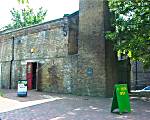 |
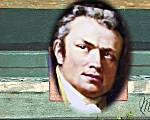 |
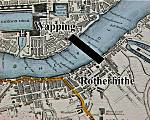 |
 |
The Brunel Museum |
Mark Isambard Brunel |
Rotherhithe to Wapping |
Tunnelling begins. |
I try to use music as an author would use chapters, full stops, exclamation marks and so forth.
Lugubrious music, for example, closes the "chapter" when the Tunnel work comes to a disastrous halt in 1828, but contrastingly cheerful music opens the next chapter, when the work is about to resume in 1834. The shaft construction "chapter" has a different, "busy" piece of music, and so on.
Appropriate music, in tandem with the editing, can build tension, as in the sequence highlighting the bad working conditions, leading up to the explosions and the floods.
In addition, short fanfares, up and down glissandos and "killer stabs" can also be used to punctuate the story like aural exclamation marks, or three full stops (. . .).
So, the creative inventor Mark Brunel is introduced with a fanfare. As the idea of a tunnel is first introduced, a down glissando mirrors the visual tilt down from bridge to tunnel. Killer stabs drive home the decline of the tunnel, and its fall into disrepute.
Underscoring Events
The music can do even more. I needed something to underscore the worm's movement, and its trick of excreting the digested wood. Worms move along silently, and there are no sound effects records! But there is music - if you're lucky enough to find it! Trackline's Wildlife CD was particularly useful for this.
Finally, research can help choose appropriately authentic music. "Rule Britannia" actually was played in that first underwater banquet!
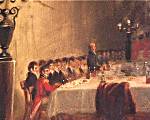 |
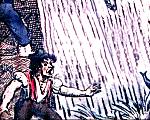 |
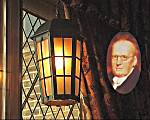 |
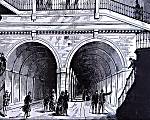 |
An underwater dinner |
But more flooding brings |
The Royal Society |
March 25th 1843 |
Sound effects records have a considerable part to play in the video, and I'm lucky that my local library has a decent selection of them on loan.
My fear of audience boredom mentioned above led me at almost every opportunity to try to add the sounds of what's represented in the static pictures to bring an excitement and a sparkle to the video.
So for the black and white images of a crowded old London Bridge, there are sounds of footsteps, crowd hubbub and horses whinnying. There are floods, explosions, horses, carts, the lapping of the Thames, and the sounds of the construction work.
Tweaking Live Sounds
But sound effects records are not exhaustive, so for some of the more memorable pieces of soundtrack, I was grateful to members of my video club (Potters Bar Cine and Video Society), for their contributions. The toasts during the underwater banquet, the birthday toasts to Mark Brunel, the women selling their trinkets in the tunnel, the crowds at the Royal Family visit and the tunnel labourers' voices, they are all their work.
I recorded them in our clubroom, but I tweaked the recordings a little on the timeline. I added echo to all the "subterranean" voices, increased the treble on some, the bass on others, and varied the sound level, so some voices sounded very near the camera, some mid-distant, and some quite some way away. Light and shade - and I was pleased with the finished result.
Sound effects can render the voiceover redundant, and enhance a movie's pace. "Less than a year later . . ." in the voiceover is followed by the sight and sounds of a flood - so no need for further voiceover.
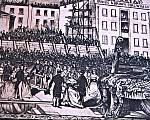 |
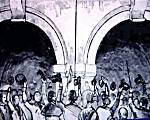 |
 |
 |
Queen Victoria visits. |
For a time the tunnel |
It was always intended |
The tunnel in current use |
But what about the voiceover?
I believe it should complement the visuals, not work against it and leave the audience to choose between concentrating on the visuals or on a commentary that is giving them facts not directly relevant to the on-screen images.
With my schoolteacher background, I aim for a clear, unambiguous voiceover that a child could follow, always closely relevant to the visuals, and pushing the story along at a brisk pace. So, no unnecessary, distracting information not supported by visuals, no repetition, no stating orally what is self-evident visually, yet the whole delivered at a pace that can be easily followed.
Put all that together, and, I hope, you get a decent sound track!
- John Astin, LACI
Share your passions.

Share your stories.